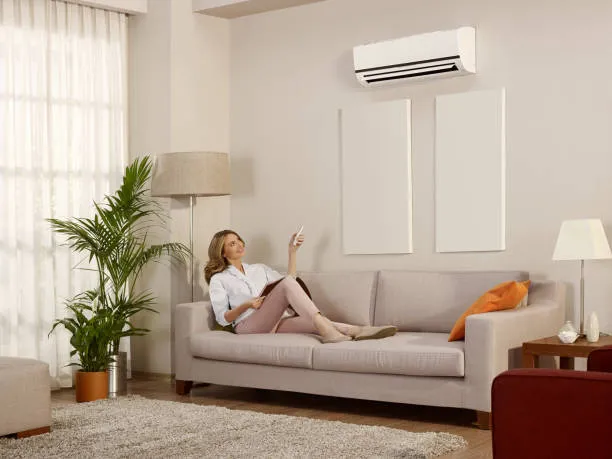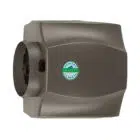
Table of Contents
Maintaining the right level of indoor humidity is crucial for your comfort and health. High humidity levels can lead to a host of problems, including mold growth, increased allergens, and even structural damage to your home. If you’ve been noticing that your home feels damp or sticky, or if you’re seeing signs of mold, it’s time to take action. Luckily, there are several effective strategies you can use to lower indoor humidity. In this guide, we’ll explore ten easy ways to reduce indoor humidity and create a more comfortable living environment.
Use a Dehumidifier
One of the most straightforward ways to tackle high indoor humidity in your home is by using a dehumidifier. These handy devices work by pulling in moist air, removing the moisture, and then releasing the dry air back into the room. There are different types of dehumidifiers to choose from, including portable units that can be moved from room to room and whole-house systems that are integrated into your home’s HVAC system. Portable dehumidifiers are great for targeting specific areas, like basements or bathrooms, while whole-house dehumidifiers provide a more comprehensive solution. Regardless of the type you choose, a dehumidifier can significantly reduce the moisture in the air, making your home more comfortable and reducing the risk of mold and mildew.
Check out top-notch dehumidifiers on our official website via the link below.
Improve Ventilation
Improving the ventilation in your home is another effective way to reduce indoor humidity. Proper ventilation helps to circulate air and prevent moisture from building up. Start by making sure that your home’s exhaust fans are in good working order. Exhaust fans are typically found in kitchens and bathrooms, where they help to remove steam and moisture generated by cooking and showering. If your exhaust fans aren’t functioning properly, or if you don’t have them installed, consider adding them. Additionally, opening windows and doors to allow fresh air to circulate can also help to reduce indoor humidity. Just be sure to do this when the outdoor humidity is lower than indoor levels to avoid bringing more moisture inside.
Take Shorter Showers

While it might be tempting to indulge in long, hot showers, doing so can contribute significantly to indoor humidity levels. The steam generated by long showers adds a considerable amount of moisture to the air, especially in a small, enclosed space like a bathroom. To combat this, try to limit your shower time and opt for cooler water whenever possible. Using an exhaust fan or opening a window during and after your shower can help to vent the steam outside, further reducing the humidity in your home.
Fix Leaks and Seal Gaps
Leaks and gaps in your home can allow moisture to enter, exacerbating humidity problems. It’s important to regularly inspect your home for any signs of leaks, such as water stains, damp spots, or mold growth. Pay particular attention to areas around windows, doors, and plumbing fixtures. If you find any leaks, repair them promptly. Additionally, sealing gaps and cracks around windows and doors with weatherstripping or caulk can help to prevent moisture from entering your home. Taking these steps not only reduces humidity but also improves your home’s energy efficiency.
Dry Your Laundry Outside
Drying laundry indoors can introduce a significant amount of moisture into the air. If possible, try to dry your clothes outside on a clothesline. If outdoor drying isn’t an option due to weather or lack of space, consider using a vented dryer or a drying rack placed in a well-ventilated area. Using a dehumidifier in the laundry area can also help to manage the moisture released during the drying process. These steps can significantly reduce indoor humidity and create a more pleasant atmosphere in your home.
Use Your Air Conditioner
Air conditioners are designed to cool your home, but they also help to reduce humidity levels. As the air conditioner cools the air, it removes moisture, which is then drained away. Make sure your air conditioner is properly sized for your home and maintained regularly to ensure it operates efficiently. If you don’t have central air conditioning, using window units or portable air conditioners in the most humid areas of your home can still make a significant difference. By keeping your air conditioner in Canada in good condition, you can effectively reduce indoor humidity and improve overall comfort.
For a professional air conditioner repair in Canada reach out to HVAC Service Solutions via the link below.

Cook with Lids On
Cooking generates a lot of steam, which can contribute to higher humidity levels in your home. To minimize this, try to cook with lids on pots and pans whenever possible. This simple step helps to contain the steam, reducing the amount of moisture released into the air. Additionally, using an exhaust fan or range hood while cooking can help to vent steam and cooking odors outside, further improving indoor air quality. This approach is an easy yet effective way to reduce indoor humidity.
Keep Houseplants in Check
While houseplants can improve indoor air quality and add a touch of nature to your home, they also release moisture into the air through a process called transpiration. If you have a lot of houseplants, this can contribute to higher humidity levels. To manage this, try to limit the number of plants in your home, especially in more humid areas like bathrooms and kitchens. Additionally, placing a few plants outside or in well-ventilated areas can help to reduce the overall moisture they release indoors. This practice helps to maintain balanced indoor humidity levels.
Use Desiccants
Desiccants are substances that absorb moisture from the air, making them an effective tool for reducing humidity. Common desiccants include silica gel, activated charcoal, and calcium chloride. You can place desiccants in areas where humidity tends to be higher, such as closets, basements, and bathrooms. Many commercial products, such as moisture-absorbing sachets and dehumidifying tubs, contain these desiccants and can be placed discreetly around your home. They work quietly and efficiently to absorb excess moisture, helping to keep your indoor environment dry and comfortable. Using desiccants is a practical solution for how to reduce humidity in house.
Maintain Your HVAC System
Your HVAC system plays a crucial role in managing indoor humidity levels. Regular maintenance ensures that it operates efficiently and effectively. This includes changing air filters regularly, having your system inspected and serviced by a professional at least once a year, and making sure that your ductwork is properly sealed. A well-maintained HVAC system not only helps to reduce humidity but also improves indoor air quality and extends the lifespan of your equipment. Additionally, consider upgrading to a system with humidity control features if your current setup doesn’t have them. Maintaining your HVAC system is key to understanding how to reduce humidity in house.
Conclusion
Reducing indoor humidity is essential for maintaining a comfortable and healthy home environment. By implementing these ten easy strategies, you can effectively manage moisture levels and prevent the problems associated with high humidity. From using dehumidifiers and improving ventilation to fixing leaks and maintaining your HVAC system, each step plays a vital role in keeping your home dry and comfortable. Remember, the key is consistency and regular maintenance. By staying proactive and attentive to the humidity levels in your home, you can create a more pleasant living space for you and your family. Implementing these tips will help you reduce indoor humidity and enjoy a better quality of life.
For top-of-the-line dehumidifiers and personalized consultation, be sure to reach out to HVAC Service Solutions via the link below.
Frequent Asked Questions
1. Why is high indoor humidity a problem?
High indoor humidity can lead to numerous issues that affect both your home and your health. Excess moisture creates a perfect environment for mold and mildew to thrive, which can cause damage to walls, ceilings, and furniture. Mold growth can also release spores into the air, triggering allergies and respiratory problems for sensitive individuals. High humidity levels can make the air feel warmer than it actually is, leading to discomfort and a reliance on air conditioning, which can increase energy bills. Additionally, excess moisture can attract pests like dust mites and cockroaches, further impacting indoor air quality. Structural problems such as wood rot and peeling paint are also common in homes with high humidity. Therefore, maintaining optimal humidity levels is essential for preserving your home and promoting a healthy living environment.
2. How can I measure the humidity levels in my home?
Measuring the humidity levels in your home is straightforward with the use of a hygrometer, a device specifically designed for this purpose. Hygrometers are widely available and come in both digital and analog forms, offering easy-to-read humidity readings. To get an accurate measurement, place the hygrometer in the room where you want to monitor humidity, away from direct sunlight and heat sources. Ideally, indoor humidity levels should be kept between 30% and 50% to ensure comfort and prevent problems associated with high humidity. Some advanced hygrometers also measure temperature, providing a more comprehensive overview of your indoor climate. Regularly checking humidity levels can help you identify and address potential issues before they become serious. If you notice consistently high or low readings, it might be time to consider using a dehumidifier or humidifier to balance the moisture levels in your home.
3. What is the most effective way to reduce indoor humidity?
The most effective way to reduce indoor humidity is by using a dehumidifier. Dehumidifiers work by drawing in humid air, removing the moisture through a cooling process, and then releasing the dry air back into the room. There are various types of dehumidifiers, including portable units for specific rooms and whole-house systems that are integrated with your HVAC system. Portable dehumidifiers are convenient for targeting problem areas such as basements, bathrooms, and laundry rooms. Whole-house dehumidifiers offer a more comprehensive solution by managing humidity levels throughout your entire home. When selecting a dehumidifier, consider factors such as the size of the area, the humidity level, and the unit’s capacity to remove moisture effectively. Regular maintenance, such as cleaning the filter and emptying the water reservoir, ensures optimal performance. By consistently using a dehumidifier, you can significantly reduce indoor humidity and create a more comfortable living environment.
4. How often should I use a dehumidifier?
The frequency of dehumidifier use depends on the humidity levels in your home and the specific conditions of your living environment. In areas with consistently high humidity, such as basements or regions with humid climates, running a dehumidifier daily may be necessary to maintain comfortable and safe moisture levels. For occasional humidity issues, such as after cooking, showering, or drying laundry indoors, using a dehumidifier as needed should suffice. Monitoring the humidity levels with a hygrometer can help you determine when to run your dehumidifier. Typically, maintaining indoor humidity between 30% and 50% is ideal. Overuse of a dehumidifier can lead to excessively dry air, which can cause issues like dry skin and respiratory irritation. Balancing usage based on current conditions ensures you manage humidity effectively without over-drying the air.
5. Can air conditioning help reduce indoor humidity?
Yes, air conditioning can help reduce indoor humidity as part of its cooling process. When an air conditioner cools the air, it also removes moisture, which is then drained away from the system. This dual function makes air conditioners an effective tool for managing indoor humidity levels. To maximize this benefit, ensure your air conditioner is properly sized for your home and is well-maintained. Regular maintenance, including cleaning or replacing filters and checking for any issues, ensures that your air conditioner operates efficiently. If you don’t have central air conditioning, using window units or portable air conditioners in the most humid areas of your home can still provide significant humidity reduction. By keeping your air conditioner in good condition and using it effectively, you can help reduce indoor humidity and improve overall comfort in your home.
6. What are some natural ways to reduce indoor humidity?
Natural ways to reduce indoor humidity include improving ventilation, taking shorter showers, cooking with lids on, and drying laundry outside. Proper ventilation is key; use exhaust fans in kitchens and bathrooms to remove steam and moisture. Opening windows and doors when the outdoor humidity is lower than indoor levels allows fresh air to circulate and reduce moisture buildup. Taking shorter, cooler showers helps minimize the steam that adds to indoor humidity. Cooking with lids on pots and pans contains steam, reducing the amount of moisture released into the air. Drying laundry outside on a clothesline instead of indoors prevents additional moisture from accumulating inside your home. Houseplants that absorb moisture, like Boston ferns and peace lilies, can also help naturally reduce humidity levels. Combining these methods can effectively manage indoor humidity without relying solely on mechanical devices.
7. How can I improve ventilation in my home?
Improving ventilation in your home is crucial for managing indoor humidity and maintaining good air quality. Start by ensuring that your kitchen and bathroom exhaust fans are functioning properly. These fans help remove moisture and steam generated from cooking and showering, preventing humidity buildup. If you don’t have exhaust fans, consider installing them in these key areas. Opening windows and doors allows fresh air to circulate and helps to reduce indoor humidity, especially when outdoor humidity levels are lower. Cross-ventilation, where air flows from one side of the home to the other, is particularly effective. Using ceiling fans and portable fans can also help to keep air moving and prevent stagnant, humid conditions. In addition, ensure that your HVAC system is well-maintained, with clean filters and properly sealed ductwork, to promote efficient air circulation. Improving ventilation not only reduces humidity but also enhances overall indoor air quality.
8. Are there any plants that can help reduce indoor humidity?
Yes, certain houseplants can help reduce indoor humidity by absorbing moisture through their leaves during the process of transpiration. Plants such as Boston ferns, peace lilies, and English ivy are particularly effective at this. Boston ferns are known for their ability to thrive in high humidity environments while absorbing moisture from the air. Peace lilies are not only good at reducing humidity but also at purifying the air by removing toxins. English ivy can also help absorb excess moisture and is easy to care for. While these plants can assist in managing humidity levels, it’s important to not overwater them, as this can counteract their benefits by adding more moisture to the air. Placing these plants in more humid areas like bathrooms and kitchens can help balance indoor humidity. Using houseplants as a natural humidity regulator is a simple and aesthetically pleasing way to maintain a comfortable indoor environment.
9. What should I do if I find leaks in my home?
If you find leaks in your home, it’s important to address them promptly to prevent moisture from entering and exacerbating humidity problems. Start by identifying the source of the leak, whether it’s from plumbing fixtures, windows, or the roof. For plumbing leaks, you might need to tighten connections, replace worn-out washers, or call a professional plumber for more significant issues. Leaks around windows and doors can often be sealed with weatherstripping or caulk to prevent moisture from seeping in. For roof leaks, inspect for damaged shingles or flashing and repair or replace them as needed. Regularly check areas prone to leaks, such as basements and attics, for signs of water damage. Repairing leaks not only helps to reduce indoor humidity but also prevents potential structural damage and mold growth. Taking these steps ensures a more comfortable and safe living environment.
10. How can HVAC Service Solutions help with indoor humidity issues?
HVAC Service Solutions can play a vital role in helping you manage and reduce indoor humidity issues effectively. They offer top-of-the-line dehumidifiers designed to handle varying levels of humidity in different parts of your home. Their expert technicians can assess your home’s specific needs and recommend the best dehumidifier options, whether you need a portable unit or a whole-house system. Additionally, HVAC Service Solutions provides personalized consultations to help you understand the root causes of your humidity problems and develop a comprehensive plan to address them. They can also offer maintenance services for your HVAC system to ensure it operates efficiently, which is crucial for managing indoor humidity. With their expertise and quality products, HVAC Service Solutions can help you create a comfortable and healthy living environment. Reach out to them for professional advice and top-tier equipment tailored to your home’s needs.
Share



















